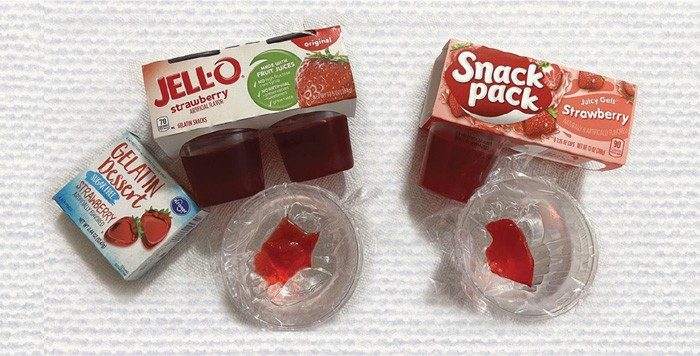By Susan Hershberger

Introduction
Fruit-flavored gel snacks are both delicious and mysterious! When you go to a grocery store, you may notice that some brands are stored in the refrigerator, while other brands are stored on a shelf at room temperature. Why are they not kept in the same place? This activity provides all the clues you need to solve this juicy mystery.
Question to investigate
Why are fruit-flavored gel snacks kept in different places at the grocery store?
Safety Suggestions
✓ Do not eat the gel or drink the water used in this activity.
✓ Ensure that the tap water is less than 110 °F or 43 °C.
✓ Dispose of used liquids down the sink. Cups and gels may be placed in the trash.
Materials
- 2 clear plastic cups (9- or 10-ounce, or about 300 mL)
- Permanent marker
- Plastic wrap
- 2 teaspoons
- 1 pack of individually-portioned fruit-flavored Jell-O, The Treat Life Gelatin Snacks, or other brand found in the refrigerated section of your grocery store
- 1 pack of individually-portioned fruit-flavored Snack Pack, Juicy Gels, Kool-Aid Gels, or other brand gels found on a shelf at your grocery store
- Comfortably warm (100-110 °F or 40-43 °C) tap water from the faucet
Note: Refrigerate both types of snacks for at least one hour before beginning this activity so they are at the same starting temperature.
Procedure
Melting Test
- Use a permanent marker to label one of the cups “CG” (for Cold Gel, found in the grocery store fridge). Label the other “SSG” (for Shelf-stable Gel, found on a grocery store shelf).
- Fill both cups about two-thirds full with warm tap water from the kitchen faucet.
- Place a piece of clear plastic wrap loosely over each cup of warm water so that it rests on the surface of the water.
- Place 1 tsp of Jell-O on top of the plastic wrap covering the CG cup, and 1 tsp of Snack Pack gel over the SSG cup. Wait 3 to 5 minutes. Which gel melts first? Draw a checkmark in the chart on this page.
- Discard the plastic wrap with the gels in the trash. Keep the cups, but refill them with fresh warm water for the next test.
Dissolving Test
- Now add 1 tsp of Jell-O into the water in the CG cup, and add 1 tsp of the Snack Pack gel into the water in the SSG cup.
- Use different spoons to stir the gel and water in each cup and wait 3-5 minutes. Which gel dissolves first? Record this in the chart.
Squishing Test
- Rub your hands together to warm the palms of your hands.
- Have an adult place 1 tsp of the Cold Gel on your right palm and 1 tsp of the Shelf-stable Gel on your left.
- Close both hands. Slightly squeeze and release your grip repeatedly to squish the gels.
- After about one minute, open your hands and compare the gels. Which gel breaks apart more? Record your observation in the chart.
Compare the Ingredients
Look for the ingredients list for each of the products. Which pack contains gelatin or carrageenan as the key ingredient? Record this in the chart.
What did you observe?
Compare the physical properties of two types of fruit-flavored gel snacks | ||
Type of Gel | Cold Gel (GC) | Shelf-stable Gel (SSG) |
| Which brand did you use? | ||
| Melting Test Which gel melts first? | ||
| Dissolving Test Which gel dissolves first? | ||
| Squishing Test Which gel is softer and juicier? | ||
| Ingredients Label Does the gel contain gelatin or carrageenan? | ||
| Why are fruit-flavored gel snacks kept in different places at the grocery store? |
How does it work?
Although the gels are similar products, they have different melting points and dissolve in water at different speeds. Typically, the Cold Gel melts and dissolves faster, while the Shelf-stable Gel breaks up more when squished. Cold Gel contains gelatin, while Shelf-stable Gel has carrageenan. How does this compare to your observations?
Gelatin is a protein made from cows and pigs. Gelatin-based products become liquid-like at room temperature. When chilled, gelatin-based snacks become a gel. Carrageenan is a long carbohydrate that comes from a red seaweed. Carrageenan-based products act like a gel at room temperature without refrigeration. Since refrigeration is expensive, not having to refrigerate gels saves money. Which type of gelled snack do you prefer? Why?
Susan Hershberger is Director, Center for Chemistry Education, Miami University in Oxford Ohio.

